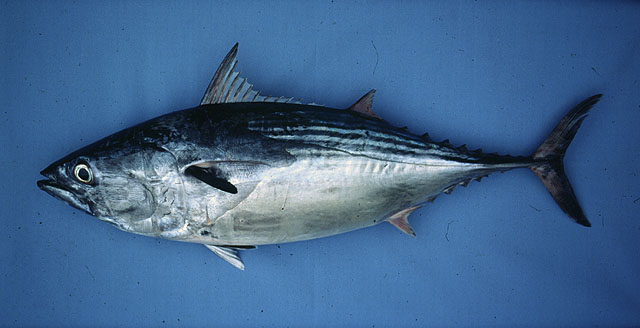| Scombridae (Mackerels, tunas, bonitos), subfamily: Scombrinae |
| 84 cm FL (male/unsexed); max.weight: 9,120.0 g |
|
pelagic-oceanic; marine; depth range 0 - 40 m, oceanodromous |
| Eastern Pacific: off San Simeon, California, USA southward to the Galapagos Islands and northern Peru. Two stray specimens collected in the Hawaiian Islands. |
|
Dorsal spines (total): 10-15; Anal soft rays: 11-12; Vertebrae: 37-37. Anterior spines of first dorsal fin much higher than those mid-way, giving the fin a strongly concave outline. Interpelvic process small and bifid. Body naked except for corselet and lateral line. Swim bladder absent. A large rounded protuberances on 31st and 32nd vertebrae. Color is generally iridescent blue with black dorsal markings composed of 3 to 5 horizontal stripes. Also with variable black or dark gray spots above the pelvic fins. Occasionally with extensive longitudinal stripes of light gray on belly; some individuals have few or no belly markings. |
| Occurs rarely where surface temperatures fall below 23°C. Its larvae are more frequently encountered at temperatures above 26°C and are practically confined to waters within about 240 miles off the mainland. Inhabits near the surface of coastal waters and offshore waters (Ref. 11035). Form multi-species schools with Thunnus albacares and Katsuwonus pelamis. An opportunistic predator which shares feeding pattern with other tunas and probably compete for food with other species such as yellowfin tuna, common dolphin, oriental bonito, among others. |
|
Least Concern (LC); Date assessed: 01 March 2022 Ref. (130435)
|
| harmless |
Source and more info: www.fishbase.org. For personal, classroom, and other internal use only. Not for publication.
